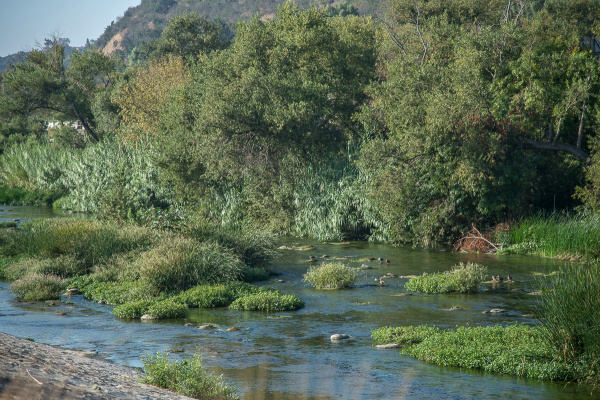Sure keeping things tidy is good for your kitchen, garage and teenager’s bedroom, but tidiness has its drawbacks, especially when you are dealing with Mother Nature and local wildlife.
Gardeners know that the messiness of rotting leaves, logs or other vegetation is a direct invitation for bugs, birds and more to “Come on in and Make Yourself at Home.”

That’s pretty much the same scenario at the Los Angeles River’s soft non-concrete channel bottoms where plant life rapidly takes hold and provides food and shelter from numerous birds, fish, insect life and more. These green spots of life in the concrete channel give us a sense of what the river may become in the years ahead especially with the river’s highly anticipated revitalization.
Those “wild river areas” could be instrumental.
Recently, environmentalists have raised concerns about the common practice of L.A. County Public Works to perform its annual L.A. River Cleaning. Every September, workers remove vegetation that has rooted in the river; which, in theory, unclogs the waterway. River clearing has been going on since 1997 when the fear of El Nino sent everyone in a cleaning frenzy.
This year, however, river activists have asked to allow the last 1 ½ miles of the river near Long Beach to remain wild and messy. Halting the routine vegetation removal will encourage the ecosystem that has been so devastated throughout the years, they say, especially in the estuary waters where the river meets the sea.
Representatives from Heal the Bay, Friends of the LA River and others pleaded their case last week to the California Regional Water Quality Control Board, asking the board to deny the renewal of the LA County Public Works five-year permit to bulldoze the river each September between Willow Street and PCH.
LA County officials say the bulldozing is necessary to manage the area as a flood control channel, keeping the waterway open and accessible.
In the end, the Board voted to limit the County to a one-year permit along with ordering it to organize workshops with community groups to try to find others ways of maintaining the riverbed without the Annual Scraping by Big Machinery.
This decision is just another chapter in the ongoing saga of the Los Angeles River. Last year, the U.S. Army Corps of Engineers recommended approval of a $1-billion proposal to restore the river habitat, creating wetlands and bike trails along the 11-mile stretch north of downtown through Elysian Park.
Now, once Congress gives its thumbs up, work will officially begin to transform that stretch, managed by the Army Corps, into a more natural landscape complete with messy tangles and wild rambles.
What lives in the Los Angeles River?
Prior to its annual Los Angeles River Cleanup in spring, Friends of the LA River has biomonitored certain areas of the river. Here’s a species breakdown that a biologist surveyed at that river near Willow Street in Long Beach from last year.
Los Angeles River–Willow St., Los Angeles, US-CA
May 7, 2014 12:10 PM – 12:50 PM
Canada Goose (Branta canadensis) 2
Gadwall (Anas strepera) 6
Mallard (Anas platyrhynchos) 90 incl. c. 20 young in 2-3 broods
Bufflehead (Bucephala albeola) 1
Double-crested Cormorant (Phalacrocorax auritus) 2
Green Heron (Butorides virescens) 1
Osprey (Pandion haliaetus) 1
American Coot (Fulica americana) 20
Black-necked Stilt (Himantopus mexicanus) 4
American Avocet (Recurvirostra americana) X Several seen north of Willow
Long-billed Dowitcher (Limnodromus scolopaceus) 1
Short-billed/Long-billed Dowitcher (Limnodromus griseus/scolopaceus) 9
Eurasian Collared-Dove (Streptopelia decaocto) 1
Anna’s Hummingbird (Calypte anna) 1
American Kestrel (Falco sparverius) 1
Black Phoebe (Sayornis nigricans) 2
Northern Rough-winged Swallow (Stelgidopteryx serripennis) X
Barn Swallow (Hirundo rustica) X
Cliff Swallow (Petrochelidon pyrrhonota) X
European Starling (Sturnus vulgaris) 2
Common Yellowthroat (Geothlypis trichas) 2 at least 2 singing from reeds
Yellow Warbler (Setophaga petechia) 1 singing from willow (trying to breed?)
California Towhee (Melozone crissalis) 1 singing from near outer edge of levee
Song Sparrow (Melospiza melodia) 1 singing c. 50 m south of Willow
Red-winged Blackbird (Agelaius phoeniceus) X Many apparently nesting in reeds along main channel
Great-tailed Grackle (Quiscalus mexicanus) 2
House Finch (Haemorhous mexicanus) 6
American Goldfinch (Spinus tristis) 2
House Sparrow (Passer domesticus) 2
FoLAR’s recent fish study at this location showed:
Atherinops affinis Topsmelt
Cyprinus carpio Carp
Mugil cephalus Stripped mullet
Gambusia affinis Mosquitofish
Pimephales promelas Fathead minnow
